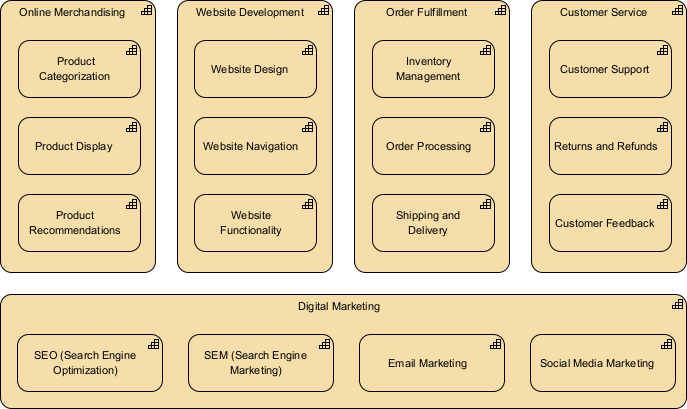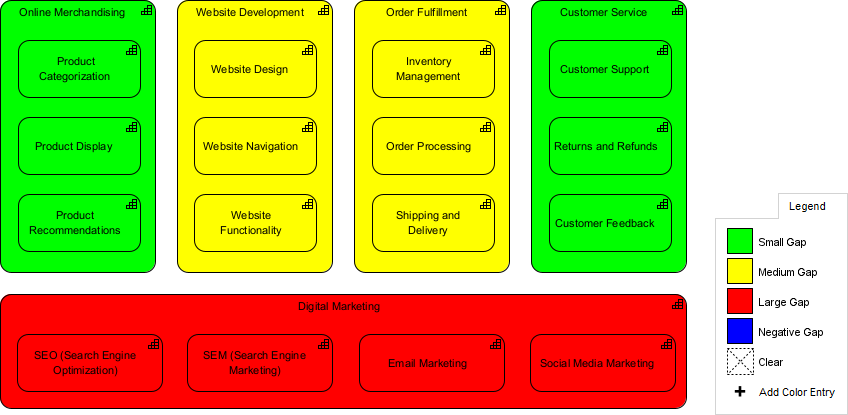Capability Map: Artifact of Vision Phase
In TOGAF (The Open Group Architecture Framework), a capability map is a tool used to organize and categorize the various capabilities of an organization. A capability is defined as the ability of an organization to perform a specific activity or function.
The capability map is typically structured as a hierarchical diagram or matrix, and it provides a high-level view of the organization’s capabilities, organized by business function or domain. The map can be used to identify areas of strength and weakness, as well as to prioritize improvement initiatives.
The capability map is an important part of the TOGAF Architecture Development Method (ADM), as it helps to identify the capabilities needed to support the organization’s business objectives and to develop a target architecture that aligns with those objectives. By understanding the organization’s capabilities and how they are related to one another, enterprise architects can design more effective solutions that support business agility, innovation, and growth.
Capability Map using ArchiMate
ArchiMate is a modeling language used to describe and visualize enterprise architectures. In ArchiMate, a Capability is a key concept that represents an organization’s ability to do something.
A Capability Map in ArchiMate provides a visual representation of an organization’s capabilities and how they relate to each other. It can help to identify areas of redundancy, inefficiency, and opportunity for improvement. The Capability Map can also be used to identify dependencies between capabilities, allowing organizations to better understand the impact of changes to one capability on other parts of the organization.
In addition to supporting decision-making and prioritization, a Capability Map in ArchiMate can be used to support the development of target architectures. By understanding the organization’s capabilities and their interrelationships, architects can design solutions that are more effective, efficient, and aligned with business goals.
Overall, a Capability Map in ArchiMate is a powerful tool for organizations to gain a holistic understanding of their capabilities and to identify areas for improvement. It helps organizations to align their capabilities with their strategic goals, and to ensure that they are focused on the right things to achieve success.
Example: Retail Company
Let’s say a retail company wants to improve its online sales capabilities. They want to create a Capability Map to help them understand their current capabilities and identify areas for improvement.
First, they would identify their main business capabilities, such as online merchandising, website development, digital marketing, order fulfillment, and customer service. They would then map out these capabilities in a hierarchical diagram, showing how they are related to each other.
By analyzing the Capability Map, the company might identify areas where they need to improve. For example, they might see that their website development capability is not as strong as it needs to be, or that their digital marketing capability is not generating enough traffic to their website. They might also identify areas of redundancy or inefficiency, such as duplicate efforts in order fulfillment.
Using the Capability Map, the company could prioritize investments and focus resources on the areas that will have the most impact on their online sales capabilities. They could also communicate their capabilities and priorities to stakeholders, such as senior management, employees, and external partners.
The Capability Map would help the retail company to better understand their current capabilities, identify areas for improvement, and align their capabilities with their strategic goal of improving online sales. By doing so, they would be better positioned to achieve success in the highly competitive e-commerce market.
Here’s an example of how the capabilities and sub-level capabilities for the retail company scenario could be organized in a textual format:
Business Capability: Online Sales
- Online Merchandising
- Product Categorization
- Product Display
- Product Recommendations
- Website Development
- Website Design
- Website Navigation
- Website Functionality
- Digital Marketing
- SEO (Search Engine Optimization)
- SEM (Search Engine Marketing)
- Email Marketing
- Social Media Marketing
- Order Fulfillment
- Inventory Management
- Order Processing
- Shipping and Delivery
- Customer Service
- Customer Support
- Returns and Refunds
- Customer Feedback
This list of capabilities and sub-level capabilities can be used to create an ArchiMate diagram that visually represents the relationships between the capabilities. The diagram could include boxes or shapes representing each capability, with lines or arrows connecting the capabilities to show their dependencies and relationships.

Addressing Maturity Gaps in ArchiMate Capability Mapping through Colorization
Colorization is a useful tool for visualizing the maturity of capabilities in a Capability Map in ArchiMate. By using color to represent the level of maturity, it is easier to identify areas where improvements may be needed and prioritize actions accordingly. The “Calculate KPIs and colorize objects” report in ArchiMate calculates values for various attributes such as Business Value, Maturity (actual), Maturity (target), and Maturity gap. These attributes can then be used to colorize the objects in the capability map based on their values.
The default attribute used for colorization is the maturity gap, where:
- red indicates a large gap,
- yellow indicates a medium gap,
- green indicates a small gap, and
- blue indicates a negative gap (i.e., the actual maturity is better than the desired one).
By using colorization in this way, it is easy to identify capabilities that require improvement and prioritize them accordingly.
Alternatively, the capability map can be colorized based on the business value of each capability. This helps to determine the seriousness of the maturity gaps and identify capabilities that have a high business value but low maturity. This can be useful when prioritizing improvements and allocating resources.
Overall, colorization is a powerful tool for identifying areas of improvement in a Capability Map and prioritizing actions to improve the maturity of an organization’s capabilities.
Here’s an example table that assigns a GAP or color to each sub-level capability:
| Business Capability | Sub-level Capability | GAP/Color |
|---|---|---|
| Online Sales | Online Merchandising | Green |
| Product Categorization | Green | |
| Product Display | Green | |
| Product Recommendations | Green | |
| Website Development | Yellow | |
| Website Design | Yellow | |
| Website Navigation | Yellow | |
| Website Functionality | Yellow | |
| Digital Marketing | Red | |
| SEO (Search Engine Optimization) | Red | |
| SEM (Search Engine Marketing) | Red | |
| Email Marketing | Red | |
| Social Media Marketing | Red | |
| Order Fulfillment | Yellow | |
| Inventory Management | Yellow | |
| Order Processing | Yellow | |
| Shipping and Delivery | Yellow | |
| Customer Service | Green | |
| Customer Support | Green | |
| Returns and Refunds | Green | |
| Customer Feedback | Green |

In this table, the sub-level capabilities are assigned a GAP/Color to represent their level of maturity or performance. Green indicates that the capability is performing well and meets the organization’s needs, yellow indicates that there is room for improvement, and red indicates that the capability needs significant improvement to meet the organization’s needs. This table could be used as a starting point for prioritizing investments and improvements in the different sub-level capabilities.
Summary
A Capability Map is a graphical representation of the capabilities of an organization or enterprise that shows the main business capabilities and how they relate to each other. It is a powerful tool for understanding and improving the capabilities of an organization, helping to identify gaps or areas where improvement is needed to achieve business goals.
The Capability Map can be used to support decision-making, prioritize investments, and focus resources on areas with the most impact. In the example scenario of a retail company, the Capability Map could include capabilities such as online sales, website development, digital marketing, order fulfillment, and customer service, with sub-level capabilities assigned a GAP/Color to indicate their level of maturity or performance. This information can be used to create an ArchiMate diagram that visually represents the relationships between capabilities, aiding communication and collaboration among stakeholders.

